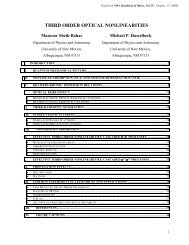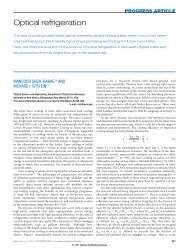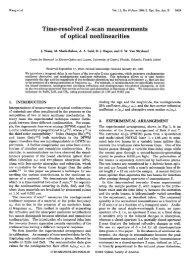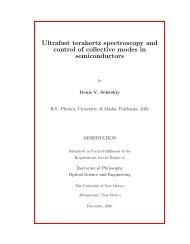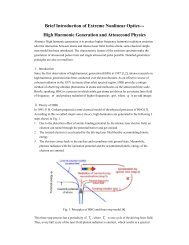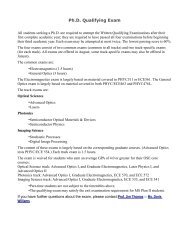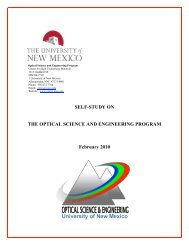Absorption spectra of wide-gap semiconductors in their ...
Absorption spectra of wide-gap semiconductors in their ...
Absorption spectra of wide-gap semiconductors in their ...
Create successful ePaper yourself
Turn your PDF publications into a flip-book with our unique Google optimized e-Paper software.
340 B. Imangholi et al. / Optics Communications 227 (2003) 337–341<br />
curves. Read<strong>in</strong>g left-to-right, all the data display a<br />
negative differential transmission followed by a<br />
peak. This is the signature <strong>of</strong> self-focus<strong>in</strong>g associated<br />
with a thermally <strong>in</strong>duced change to the refractive<br />
<strong>in</strong>dex. The dataset for GaP has a very high<br />
signal-to-noise ratio, but shows some deviation<br />
from the calculated curve at displacements far<br />
from z ¼ 0. We attribute this to aberrations <strong>in</strong>troduced<br />
by the pump focus<strong>in</strong>g lens that prevent<br />
realization <strong>of</strong> an ideal Gaussian beam. Material<br />
parameters relevant for our analysis are shown <strong>in</strong><br />
Table 1; this <strong>in</strong>formation is primarily obta<strong>in</strong>ed<br />
from the manufacturers. Extracted l<strong>in</strong>ear absorption<br />
coefficients <strong>in</strong> the wavelength range 840–900<br />
nm are displayed <strong>in</strong> Fig. 4. TiO 2 is known to have<br />
birefr<strong>in</strong>gence <strong>in</strong> the near-<strong>in</strong>frared [7], but we are<br />
unable to detect changes <strong>in</strong> the response when the<br />
sample is rotated on its azimuth.<br />
The ZnSe data are corrected for the presence <strong>of</strong><br />
two-photon absorption (TPA). This nonl<strong>in</strong>ear<br />
optical phenomenon can occur via two different<br />
physical pathways: (i) absorption <strong>of</strong> two photons<br />
from the Ti:sapphire pump laser (degenerate TPA)<br />
and/or (ii) absorption <strong>of</strong> one near-<strong>in</strong>frared photon<br />
from the Ti:sapphire laser and one visible photon<br />
from the He–Ne probe laser (non-degenerate<br />
TPA). The very low probe power <strong>of</strong> our experiment<br />
and the mode-mismatch condition make the<br />
second process negligible. Degenerate TPA, however,<br />
can become comparable to the l<strong>in</strong>ear absorption<br />
at sufficiently high irradiance. This can be<br />
accounted for by writ<strong>in</strong>g an irradiance-dependent<br />
absorption coefficient<br />
aðI excite ; zÞ ¼a þ 1 2 bI exciteðzÞ;<br />
ð3Þ<br />
<strong>Absorption</strong> Coefficent (cm -1 )<br />
0.33<br />
0.32<br />
0.31<br />
0.30<br />
0.29<br />
0.008<br />
0.006<br />
0.004<br />
0.0012<br />
0.0008<br />
0.0004<br />
8x10 -5<br />
6x10 -5<br />
4x10 -5<br />
GaP<br />
TiO 2<br />
ZnSe<br />
ZnS<br />
840 850 860 870 880 890 900 910<br />
Fig. 4. L<strong>in</strong>ear absorption coefficients for the four materials<br />
studied.<br />
where b is the degenerate TPA coefficient, and<br />
I excite is the on-axis pump <strong>in</strong>tensity at a given position<br />
(z). A geometric factor <strong>of</strong> 1/2 accounts for a<br />
spatially averaged Gaussian pump beam. We<br />
separate l<strong>in</strong>ear from nonl<strong>in</strong>ear absorption us<strong>in</strong>g<br />
the follow<strong>in</strong>g procedure: The sample is translated<br />
to the position <strong>of</strong> maximum differential probe<br />
transmission (i.e., the po<strong>in</strong>t <strong>of</strong> peak signal). The<br />
pump irradiance is then varied to generate the data<br />
shown <strong>in</strong> Fig. 5. Deviations from a l<strong>in</strong>ear response<br />
(solid l<strong>in</strong>e) <strong>in</strong>dicate the presence <strong>of</strong> degenerate<br />
Table 1<br />
Material parameters used <strong>in</strong> the analysis<br />
E g<br />
(eV)<br />
n<br />
j<br />
(W/(cm deg))<br />
C p<br />
(J/(cm 3 deg))<br />
D<br />
(cm 2 /s)<br />
dn=dT<br />
(deg 1 )<br />
ð1=LÞðdL=dT Þ<br />
(deg 1 )<br />
ZnS 3.8 2.4 0.19 1.91 0.099 6.4 10 5 6.497 10 6<br />
ZnSe 2.67 2.46 0.16 1.79 0.089 1.06 10 4 7.57 10 6<br />
TiO 2 3.65 2.9 0.11 3.05 0.036 )5.7 10 7 8.17 10 6<br />
GaP 2.25 3.3 1.1 1.78 0.62 3.3 10 4 4.65 10 6<br />
H 2 O – – 0.6 4.2 0.14 )8 10 5 –<br />
Samples were acquired from Lambda Precision Optics, Costa Mesa, CA (ZnS, ZnSe); Crystallod, Somerville, NJ (TiO 2 ); MTI,<br />
Richmond, CA (GaP).


